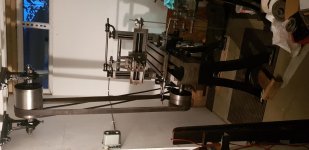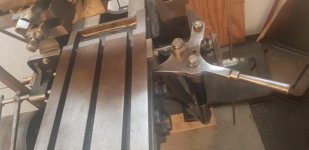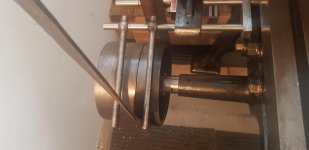wotcherman
Aluminum
- Joined
- Mar 28, 2007
- Location
- London UK
Hi to all
I've had a number of projects on the go and have spent a lot of time on this one....
Its a fairly rare Henry Milnes 24 in planing machine- a tiny little thing by US standards but its what I can fit in..
I'm getting near the end of the restoration and I just cant get the fast and loose belt shifting mechanism to work. The trouble is there is very little out there on optimising a fast and loose planer belt shifter and i'm working with just a catalogue picture and what was a derelict machine which hadn't worked for many years so im bound to have got something wrong....
Hopefully ive managed to attach some pictures...
There is a normal three stage pulley set on the side of the machine..centre is loose either side is drive...and a belt shifting mechanism which is a round rod driven by a control crank on the far side of the machine- operated by stops on the side of the table...
Ive got a n old lawnmover drum skimmed down to act as the countershaft drum
pulley centres are about 4ft 6in drum dia 8in which just about matches the three pulley set
contershaft speed about 220 rpm...catalogue says 205
The basic problem is that with the belt tension set so that it barely drives the outer drive pulleys...it wont shift across- it just twists up and hangs there...
I've got some questions based on my observations of US machines on youtube etc and im hoping that the knowledgible wise ones out there may be able to help...
Do the shifter forks have to work on the slack side or the tension side of the drive pulley?
how far away should they be from the drive pulley?
The machine pulleys are 2in wide so I've assumed a 2in wide belt.....I'e been looking on youtube and there seem to be bigger machines running belts which are not as wide as the pulleys...could it be that my belt is too wide for the centres and I should be running a narrower belt with more tension?
All suggestions gratefully received ...it would be nice to make some planer ships.....im quite cloes yet so far...
Regards
John
I've had a number of projects on the go and have spent a lot of time on this one....
Its a fairly rare Henry Milnes 24 in planing machine- a tiny little thing by US standards but its what I can fit in..
I'm getting near the end of the restoration and I just cant get the fast and loose belt shifting mechanism to work. The trouble is there is very little out there on optimising a fast and loose planer belt shifter and i'm working with just a catalogue picture and what was a derelict machine which hadn't worked for many years so im bound to have got something wrong....
Hopefully ive managed to attach some pictures...
There is a normal three stage pulley set on the side of the machine..centre is loose either side is drive...and a belt shifting mechanism which is a round rod driven by a control crank on the far side of the machine- operated by stops on the side of the table...
Ive got a n old lawnmover drum skimmed down to act as the countershaft drum
pulley centres are about 4ft 6in drum dia 8in which just about matches the three pulley set
contershaft speed about 220 rpm...catalogue says 205
The basic problem is that with the belt tension set so that it barely drives the outer drive pulleys...it wont shift across- it just twists up and hangs there...
I've got some questions based on my observations of US machines on youtube etc and im hoping that the knowledgible wise ones out there may be able to help...
Do the shifter forks have to work on the slack side or the tension side of the drive pulley?
how far away should they be from the drive pulley?
The machine pulleys are 2in wide so I've assumed a 2in wide belt.....I'e been looking on youtube and there seem to be bigger machines running belts which are not as wide as the pulleys...could it be that my belt is too wide for the centres and I should be running a narrower belt with more tension?
All suggestions gratefully received ...it would be nice to make some planer ships.....im quite cloes yet so far...
Regards
John













